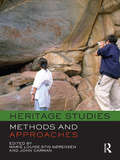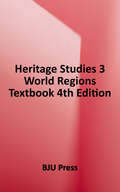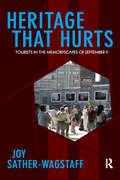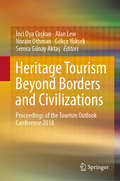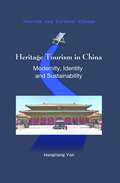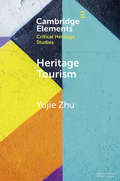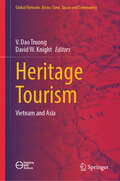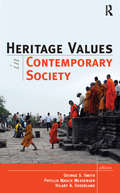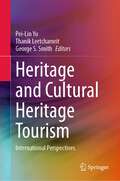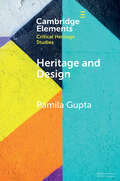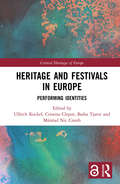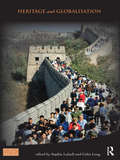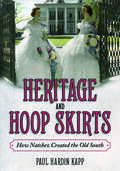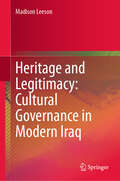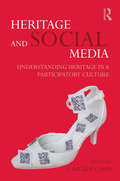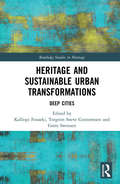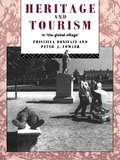- Table View
- List View
Heritage Studies 5, Fourth Edition
by Annittia Jackson Brian C. Collins Eileen Berry Ethan BirneyBJU Press Heritage Studies 5 presents the narrative of American history from the creation of the car in the late 1800s through the 2015 Clean Power plan. Photographs, illustrations, maps, timelines, and notes highlight themes of geography, American history, government, economics, world history, and culture. Topics are presented from a biblical perspective and include the invention and influence of the automobile and airplane, World War I, the Roaring Twenties, the Great Depression, World War II, the Vietnam War, struggles over civil rights, the war on terror, Afghanistan and Iraq wars, and immigration decisions, all from a Christian worldview. This study highlights the role of significant Christians in American history and their viewpoints on historical events. This resource is also known as Bob Jones Heritage Studies Grade 5 Text, 4th Edition.
Heritage Studies 6: Ancient Civilizations Activity Manual
by Bju PressHeritage Studies Grade 6, Ancient Civilizations Activity Manual, Fourth Edition by BJU Press
Heritage Studies: Methods and Approaches
by Marie Louise Stig Sørensen John CarmanThis is the first volume specifically dedicated to the consolidation and clarification of Heritage Studies as a distinct field with its own means of investigation. It presents the range of methods that can be used and illustrates their application through case studies from different parts of the world, including the UK and USA. The challenge that the collection makes explicit is that Heritage Studies must develop a stronger recognition of the scope and nature of its data and a concise yet explorative understanding of its analytical methods. The methods considered fall within three broad categories: textual/discourse analysis, methods for investigating people’s attitudes and behaviour; and methods for exploring the material qualities of heritage. The methods discussed and illustrated range from techniques such as text analysis, interviews, participant observation, to semiotic analysis of heritage sites and the use of GIS. Each paper discusses the ways in which methods used in social analysis generally are explored and adapted to the specific demands that arise when applied to the investigation of heritage in its many forms. Heritage Studies is a seminal volume that will help to define the field. The global perspective and the shared focus upon the development of reflexive methodologies ensure that the volume explores these central issues in a manner that is simultaneously case-specific and of general relevance.
Heritage Studies: World Regions
by Bju PressWorld Regions is an age-appropriate study of our global community with a special emphasis on government and citizenship, geography and climate, resources and economics, culture, and religion. Stories and legends, engaging art and photos, maps, infographics, essential questions, and literacy skills features promote student learning.
Heritage That Hurts: Tourists in the Memoryscapes of September 11 (Heritage, Tourism, and Community #4)
by Joy Sather-WagstaffMemorial sites, sites of “dark tourism,” are vernacular spaces that are continuously negotiated, constructed, and reconstructed into meaningful places. Using the locale of the 9/11 tragedy, Joy Sather-Wagstaff explores the constructive role played by tourists in understanding social, political, and emotional impacts of a violent event that has ramifications far beyond the local population. Through in-depth interviews, photographs, graffiti, even souvenirs, she compares the 9/11 memorial with other hurtful sites—the Oklahoma City National Memorial, Vietnam Veteran’s Memorial, and others—to show how tourists construct and disperse knowledge through performative activities, which make painful places salient and meaningful both individually and collectively.
Heritage Tourism Beyond Borders and Civilizations: Proceedings of the Tourism Outlook Conference 2018
by Alan Lew Norain Othman İnci Oya Coşkun Gökçe Yüksek Semra Günay AktaşThis book gathers the best papers presented at the 11th Tourism Outlook Conference, held in Eskişehir, Turkey, from 3 to 5 October 2018. Covering various aspects of heritage and its effects on tourism issues, the contributions provide a multidisciplinary perspective on emerging issues and challenges in the area. The book also analyzes both the tangible and intangible properties of natural, cultural, and historical heritage and how these relate to and influence tourism, and evaluates the importance and role of heritage in tourism destinations and products. By providing a platform for cross-disciplinary dialogues that integrate research and insights from diverse geographical, sectoral and institutional perspectives, the book allows readers to gain a better understanding of heritage tourism.
Heritage Tourism in China: Modernity, Identity and Sustainability
by Hongliang YanThis book offers new approaches and insights into the relationships between heritage tourism and notions of modernity, identity building and sustainable development in China. It demonstrates that the role of the state, politics, institutional arrangements and tradition have a considerable impact on perceptions of these notions. The volume contributes to current debates on tradition and modernity; the study of heritage tourism; the negotiated power between stakeholders in tourism planning and policy-making and the study of China’s society. The approach and findings of the book are of value to those interested in the continuities and changes in Chinese society and to graduate students and researchers in tourism, cultural studies and China studies.
Heritage Tourism: From Problems to Possibilities (Elements in Critical Heritage Studies)
by Yujie ZhuAs one of the world's fastest growing industries, heritage tourism is surrounded by political and ethical issues. This research explores the social and political effects and implications of heritage tourism through several pertinent topics. It examines the hegemonic power of heritage tourism and its consequences, the spectre of nationalism and colonialism in heritage-making, particularly for minorities and indigenous peoples, and the paradox of heritage tourism's role in combating these issues. Drawing from global cases, the study addresses a range of approaches and challenges of empowerment within the context of heritage tourism, including cultural landscapes, intangible heritage and eco-museums. The research argues that heritage tourism has the potential to develop as a form of co-production. It can be used to create a mechanism for community-centred governance that integrates recognition and interpretation and promotes dialogue, equity and diversity.
Heritage Tourism: Vietnam and Asia (Global Vietnam: Across Time, Space and Community)
by V. Dao Truong David W. KnightThis book provides an overview of research and best practices associated with heritage tourism, with a particular focus on Vietnam, in conversation with heritage tourism in other Asian contexts. These include Iran in the Middle East, Sri Lanka in South Asia, Japan and China in East Asia, Thailand in Southeast Asia, and Brunei and the Philippines in the South Pacific. By delving into crucial questions and challenges relating to cultural innovation, preservation, and authenticity, it offers key lessons for policy-making and theorisation which not only contribute to understanding and improving heritage tourism in Vietnam, specifically, and in Asia more broadly, but also inform efforts to preserve and regenerate both natural and cultural heritage on a global scale. It is relevant to researchers and student communities working within areas of heritage, sustainability, tourism, geography, and in Asian studies.
Heritage Values in Contemporary Society
by George S Smith Hilary A Soderland Phyllis Mauch MessengerWhat do we value about the past? In formulating policies about heritage preservation, that is the inevitable question, and deals not only with economic value but also the intangible value to individuals, communities and society as a whole. This interdisciplinary group of scholars—anthropologists, archaeologists, architects, educators, lawyers, heritage administrators, policy analysts, and consultants—make the first attempt to define and assess heritage values on a local, national and global level. Chapters range from the theoretical to policy frameworks to case studies of heritage practice, written by scholars from eight countries.
Heritage Wood: Investigation and Conservation of Art on Wood (Cultural Heritage Science)
by Austin Nevin Malgorzata SawickiThis volume highlights recent research efforts in the conservation and investigation of works of art on wood. Through eleven case studies it showcases different experimental methods ranging from X-ray analysis of objects to the study of cross-sections made from micro-samples. New research focusing on the technical study, treatment and assessment of works of art on wood in its many forms is featured in this edited volume. Technical studies include the attribution and investigations of a triptych by Hans Memling and a sculpture from workshop of Michel and Gregor Erhart, decorated Syrian rooms, and investigations of finely carved Gothic wooden objects. Synchrotron-based methods are presented for studying the alteration of 19th c. verdigris in Norway, and multi-analytical methods are employed for the investigations of 16th to 19th c. East Asian lacquer from the Kunsthistorisches Museum in Vienna. Novel methods for the cleaning of gilded surfaces using gels and emulsions are shown, as are innovative strategies for the consolidation for waterlogged wood, providing key data for the assessment of risks and benefits of new methods, and the short and long-term effects on gilding layers and archaeological wood. The book clearly shows how collaboration between engineers, physicists, biologists and chemists and conservators of different types of materials can lead to new research in conservation science. This book is crucial reading for conservators and conservation scientists, as well as for technical art historians, providing key methodological case studies of polychromy from different temporal and geographical contexts.
Heritage and Archaeology in the Digital Age: Acquisition, Curation, And Dissemination Of Spatial Cultural Heritage Data (Quantitative Methods In The Humanities And Social Sciences Ser.)
by Thomas E. Levy Marinos Ioannides Matthew L. Vincent Víctor Manuel López-Menchero BendichoThis book examines how computer-based programs can be used to acquire ‘big’ digital cultural heritage data, curate, and disseminate it over the Internet and in 3D visualization platforms with the ultimate goal of creating long-lasting “digital heritage repositories.’ The organization of the book reflects the essence of new technologies applied to cultural heritage and archaeology. Each of these stages bring their own challenges and considerations that need to be dealt with. The authors in each section present case studies and overviews of how each of these aspects might be dealt with. While technology is rapidly changing, the principles laid out in these chapters should serve as a guide for many years to come. The influence of the digital world on archaeology and cultural heritage will continue to shape these disciplines as advances in these technologies facilitate new lines of research. serif">The book is divided into three sections covering acquisition, curation, and dissemination (the major life cycles of cultural heritage data). Acquisition is one of the fundamental challenges for practitioners in heritage and archaeology, and the chapters in this section provide a template that highlights the principles for present and future work that will provide sustainable models for digital documentation. Following acquisition, the next section highlights how equally important curation is as the future of digital documentation depends on it. Preservation of digital data requires preservation that can guarantee a future for generations to come. The final section focuses on dissemination as it is what pushes the data beyond the shelves of storage and allows the public to experience the past through these new technologies, but also opens new lines of investigation by giving access to these data to researchers around the globe. Digital technology promises significant changes in how we approach social sciences, cultural heritage, and archaeology. However, researchers must consider not only the acquisition and curation, but also the dissemination of these data to their colleagues and the public.Throughout the book, many of the authors have highlighted the usefulness of Structure from Motion (SfM) work for cultural heritage documentation; others the utility and excitement of crowdsourcing as a ‘citizen scientist’ tool to engage not only trained students and researchers, but also the public in the cyber-archaeology endeavor. Both innovative tools facilitate the curation of digital cultural heritage and its dissemination. Together with all the chapters in this volume, the authors will help archaeologists, researchers interested in the digital humanities and scholars who focus on digital cultural heritage to assess where the field is and where it is going.
Heritage and Community Engagement: Collaboration Or Contestation?
by Emma Waterton Steve WatsonThis book is about the way that professionals in archaeology and in other sectors of heritage interact with a range of stakeholder groups, communities and the wider public. Whilst these issues have been researched and discussed over many years and in many geographical contexts, the debate seems to have settled into a comfortable stasis wherein it is assumed that all that can be done by way of engagement has been done and there is little left to achieve. In some cases, such engagement is built on legislation or codes of ethics and there can be little doubt that it is an important and significant aspect of heritage policy. This book is different, however, because it questions not so much the motivations of heritage professionals but the nature of the engagement itself, the extent to which this is collaborative or contested and the implications this has for the communities concerned. Furthermore, in exploring these issues in a variety of contexts around the world, it recognises that heritage provides a source of engagement within communities that is separate from professional discourse and can thus enable them to find voices of their own in the political processes that concern them and affect their development, identity and well-being. This book was published as a special issue of the International Journal of Heritage Studies.
Heritage and Cultural Heritage Tourism: International Perspectives
by Pei-Lin Yu George S. Smith Thanik LertcharnritThis book presents the state of the art on cultural heritage and tourism globally. Divided into four themes of historical and economic contexts; building resilient societies; de-colonization, community, and placemaking; and empowerment and social capital, the book analyses the relevance of heritage and includes case studies in sustainable cultural heritage. It offers vital context and guidance for those working in heritage management and also presents emerging cultural heritage challenges and opportunities.The volume presents a research agenda for understanding the role of heritage in identity, ecology, health and well-being and its application to heritage tourism. It discusses the need for partnerships between tourism and cultural heritage management and the need to establish better information sharing for establishing joint research initiatives. The central importance of sharing and incorporating Indigenous and/or local voices in order to expand tourists' understanding of cultural heritage runs throughout the volume. The book highlights on-the-ground tools and guidance for cultural heritage resource managers and includes a discussion on emerging and convergent challenges such as the impacts of COVID-19 and climate disasters, featuring heritage and tourism from across the globe with emphasis on the dynamic situation in East and SE Asia. A concluding chapter summarizes themes and trends and future directions for this area of research with a focus on theoretical contributions. This book is of interest to heritage scholars and practitioners.
Heritage and Design: Ten Portraits from Goa (India) (Elements in Critical Heritage Studies)
by Pamila GuptaThis Element looks at the relationship between heritage and design by way of a case study approach. It offers up ten distinct portraits of a range of heritage makers located in Goa, a place that has been predicated on its difference, both historical and cultural, from the rest of India. A former Portuguese colonial enclave (1510–1961) surrounded by what was formerly British India (1776–1947), the author attempts to read Goa's heritage as a form of place-ness, a source of inspiration for further design work that taps into the Goa of the twenty-first century. The series of portraits are visual, literary, and sensorial, and take the reader on a heritage tour through a design landscape of villages, markets, photography festivals, tailors and clothing, books, architecture, painting, and decorative museums. They do so in order to explore heritage futures as increasingly dependent on innovation, design, and the role of the individual.
Heritage and Festivals in Europe: Performing Identities (Critical Heritages of Europe)
by Ullrich Kockel Máiréad Nic Craith Cristina Clopot Baiba TjarveHeritage and Festivals in Europe critically investigates the purpose, reach and effects of heritage festivals. Providing a comprehensive and detailed analysis of comparatively selected aspects of intangible cultural heritage, the volume demonstrates how such heritage is mobilised within events that have specific agency, particularly in the production and consumption of intrinsic and instrumental benefits for tourists, local communities and performers. Bringing together experts from a wide range of disciplines, the volume presents case studies from across Europe that consider many different varieties of heritage festivals. Focusing primarily on the popular and institutional practices of heritage making, the book addresses the gap between discourses of heritage at an official level and cultural practice at the local and regional level. Contributors to the volume also study the different factors influencing the sustainable development of tradition as part of intangible cultural heritage at the micro- and meso-levels, and examine underlying structures that are common across different countries. Heritage and Festivals in Europe takes a multidisciplinary approach and as such, should be of interest to scholars and students in the fields of heritage studies, tourism, performing arts, cultural studies and identity studies. Policymakers and practitioners throughout Europe should also find much to interest them within the pages of this volume.
Heritage and Globalisation (Key Issues in Cultural Heritage)
by Sophia LabadiThis volume analyzes the politics, policy and practice of cultural heritage at the global level, identifying the major directions in which international heritage practice is moving, and exploring the key issues likely to shape the cultural heritage field well into the twenty-first century. It examines the tensions between the universal claims of much heritage practice, particularly that associated with the World Heritage system, and national and local perspectives. It explores the international legal framework developed since World War Two to protect heritage, particularly at times of war, and from theft, showing how contemporary global problems of conflict and illicit trade continue to challenge the international legal system. Heritage and Globalisation critiques the incorporation of heritage in the world economy through the policies of international development organisations and the global tourism trade. It also approaches heritage from seldom-considered perspectives, as a form of aid, as a development paradigm, and as a form of sustainable practice. The book identifies some of the most pressing issues likely to face the heritage industry at a global level in coming decades, including the threat posed by climate change and the need for poverty reduction. Providing a historically and theoretically rigorous approach to heritage as a form of and manifestation of globalisation, the volume’s emphasis is on contemporary issues and new fields for heritage practice.
Heritage and Hoop Skirts: How Natchez Created the Old South
by Paul Hardin KappWinner of the 2023 John Brinckerhoff Jackson Book PrizeWinner of the 2023 UMW Center for Historic Preservation Book PrizeWinner of the 2023 Fred B. Kniffen Award from the International Society for Landscape, Place, & Material CultureWinner of the 2023 Michael V. R. Thomason Book Award from the Gulf South Historical AssociationFor over eighty years, tourists have flocked to Natchez, Mississippi, seeking the “Old South,” but what they encounter is invention: a pageant and rewrite of history first concocted during the Great Depression. In Heritage and Hoop Skirts: How Natchez Created the Old South, author Paul Hardin Kapp reveals how the women of the Natchez Garden Club saved their city, created one of the first cultural tourism economies in the United States, changed the Mississippi landscape through historic preservation, and fashioned elements of the Lost Cause into an industry. Beginning with the first Natchez Spring Pilgrimage of Antebellum Homes in 1932, such women as Katherine Grafton Miller, Roane Fleming Byrnes, and Edith Wyatt Moore challenged the notion that smokestack industries were key to Natchez’s prosperity. These women developed a narrative of graceful living and aristocratic gentlepeople centered on grand but decaying mansions. In crafting this pageantry, they created a tourism magnet based on the antebellum architecture of Natchez. Through their determination and political guile, they enlisted New Deal programs, such as the WPA Writers’ Project and the Historic American Buildings Survey, to promote their version of the city. Their work did save numerous historic buildings and employed both white and African American workers during the Depression. Still, the transformation of Natchez into a tourist draw came at a racial cost and further marginalized African American Natchezians. By attending to the history of preservation in Natchez, Kapp draws on a rich archive of images, architectural documents, and popular culture to explore how meaning is assigned to place and how meaning evolves over time. In showing how and why the Natchez buildings of the “Old South” were first preserved, commercialized, and transformed into a brand, this volume makes a much-needed contribution to ongoing debates over the meaning attached to cultural patrimony.
Heritage and Identity: Engagement and Demission in the Contemporary World (Museum Meanings)
by Marta Anico Elsa PeraltaHeritage and Identity explores the complex ways in which heritage actively contributes to the construction and representation of identities in contemporary societies, providing a comprehensive account of the diverse conceptions of heritage and identity across different continents and cultures. This collection of thought-provoking articles from experts in the field captures the richness and diversity of the interlinked themes of heritage and identity. Heritage is more than a simple legacy from the past, and incorporates all elements, past and present, that have the ability to represent particular identities in the public sphere. The editors introduce and discuss a wide range of interconnected topics, including multiculturalism and globalization, local and regional identity, urban heritage, difficult memories, conceptions of history, ethnic representations, repatriation, ownership, controversy, contestation, and ethics and social responsibility. The volume places empirical data within a theoretical and analytical framework and presents an interdisciplinary approach to the study of the representation of the past, invaluable for anyone interested in heritage and museum studies.
Heritage and Its Missions: Contested Meanings and Constructive Appropriations (Catholic Practice in the Americas)
by Cristóbal Gnecco and Adriana Schmidt DiasExplores how heritage discourses and local publics interact at Catholic mission sites in the southwestern United States, northern Mexico, and the Southern ConeInterdisciplinary in scope and classed under the name “critical heritage studies,” Heritage and Its Missions makes extensive use of ethnographic perspectives to examine heritage not as a collection of inert things upon which a general historical interest is centered, but as a series of active meanings that have consequences in the social, political, and economic arenas. This approach considers the places of interaction between heritage discourses and local publics as constructed spaces where the very materiality of the social and the political unfolds.Heritage and Its Missions brings together researchers from several countries interested in the pre-republican Catholic missions in the Americas as heritage. Each essay discusses the past and current heritage meanings applied to a specific mission by national and multicultural states, local Indigenous and non-Indigenous communities, international heritage institutions, and scholars. They then address how heritage actors produce knowledge from their positioned perspectives; how different actors, collectives, communities, and publics relate to them; how heritage representations are deployed and contested as social facts; and how different conceptions of “heritage” collide, collaborate, and intersperse to produce the meanings around which heritage struggles unfold.
Heritage and Legitimacy: Cultural Governance in Modern Iraq
by Madison LeesonThis book offers cultural governance as a theoretical framework for the exploration of 20th-century Iraqi political history, from the foundation of the Imperial Tribal School in Constantinople in 1892 until 1992, the end of the Iraq-Kuwait crisis. Case studies investigate the diversity of cultural governance as an analytical tool for historical heritage management, from the protection of antiquities and guardianship of holy shrines to the use of heritage for corporate legitimacy, the dissemination of conservation expertise throughout the Arab world, and management of heritage in times of conflict. This material explores negotiations of power and sovereignty between local caretakers, officials of the Mandate administration, members of the Iraqi and Arab intelligentsia, UNESCO consultants, and Iraqi state officials, among others, underlining the ideological pluralism of governance efforts throughout the period. This research offers a historical analysis of cultural projects and programs in Iraq to consider the sociopolitical conditions that shaped their governance. The material included this book is based on previously unpublished archives from the Ottoman Prime Ministry Archives, Middle East and North African Newspapers Collection, and UNESCO Archives, among other repositories. The work addresses a gap in scholarship which has neglected the role of cultural governance in heritage management and development in Iraq. The primary audience is academic scholars, historians, and educational institutions although the book will also be of interest to individuals in Iraq, in the Iraqi diaspora abroad, and those with a general interest in modern Middle East studies.
Heritage and Memory of War: Responses from Small Islands (Contributions To Global Historical Archaeology #1)
by Gilly Carr Keir ReevesEvery large nation in the world was directly or indirectly affected by the impact of war during the course of the twentieth century, and while the historical narratives of war of these nations are well known, far less is understood about how small islands coped. These islands – often not nations in their own right but small outposts of other kingdoms, countries, and nations – have been relegated to mere footnotes in history and heritage studies as interesting case studies or unimportant curiosities. Yet for many of these small islands, war had an enduring impact on their history, memory, intangible heritage and future cultural practices, leaving a legacy that demanded some form of local response. This is the first comprehensive volume dedicated to what the memories, legacies and heritage of war in small islands can teach those who live outside them, through closely related historical and contemporary case studies covering 20th and 21st century conflict across the globe. The volume investigates a number of important questions: Why and how is war memory so enduring in small islands? Do factors such as population size, island size, isolation or geography have any impact? Do close ties of kinship and group identity enable collective memories to shape identity and its resulting war-related heritage? This book contributes to heritage and memory studies and to conflict and historical archaeology by providing a globally wide-ranging comparative assessment of small islands and their experiences of war. Heritage of War in Small Island Territories is of relevance to students, researchers, heritage and tourism professionals, local governments, and NGOs.
Heritage and Social Media: Understanding heritage in a participatory culture
by Elisa GiaccardiHeritage and Social Media explores how social media reframes our understanding and experience of heritage. Through the idea of ‘participatory culture’ the book begins to examine how social media can be brought to bear on the encounter with heritage and on the socially produced meanings and values that individuals and communities ascribe to it. To highlight the specific changes produced by social media, the book is structured around three major themes: Social Practice. New ways of understanding and experiencing heritage are emerging as a result of novel social practices of collection, representation, and communication enabled and promoted by social media. Public Formation. In the presence of widely available social technologies, peer-to-peer activities such as information and media sharing are rapidly gaining momentum, as they increasingly promote and legitimate a participatory culture in which individuals aggregate on the basis of common interests and affinities. Sense of Place. As computing becomes more pervasive and digital networks extend our surroundings, social media and technologies support new ways to engage with the people, interpretations and values that pertain to a specific territorial setting. Heritage and Social Media provides readers with a critical framework to understand how the participatory culture fostered by social media changes the way in which we experience and think of heritage. By introducing readers to how social media are theorized and used, particularly outside the institutional domain, the volume reveals through groundbreaking case studies the emerging heritage practices unique to social media. In doing so, the book unveils the new issues that are emerging from these practices and the new space for debate and critical argumentation that is required to illuminate what can be done in this burgeoning sector of heritage work.
Heritage and Sustainable Urban Transformations: Deep Cities
by Torgrim Sneve Guttormsen Grete Swensen Kalliopi FousekiHeritage and Sustainable Urban Transformations introduces the concept of ‘deep cities’, a novel approach to the understanding and management of sustainable historic cities that will advance knowledge about how the long-term, temporal and transformative character of urban heritage can be better integrated into urban policies for sustainable futures. Contrary to the growing emphasis on green or smart cities, which focus only on the present and future, the concept of ‘deep cities’ offers an approach that combines an in-depth understanding of the past with the present and future. Bringing together chapters that cover theoretical, methodological and management issues related to ‘deep cities’, the volume argues that using this approach will force researchers, managers and consultants to actively use the heritage and history of a city in the planning and management of sustainable cities. Exploring different definitions of ‘deep cities’, the book reveals varying and sometimes conflicting views among stakeholders concerning how, where and when the depth of a city should be conceptualized. Despite this, the book demonstrates how this new approach can help to create robust cities for the future, as new and innovative solutions are combined with the preservation and strengthening of historical features. Heritage and Sustainable Urban Transformations is the first international collection on the subject of sustainable historic cities. As such, the book will be of great interest to academics and students engaged in the study of heritage, heritage management, architecture, heritage conservation, anthropology, development studies, geography, planning and archaeology.
Heritage and Tourism in The Global Village (Heritage: Care-Preservation-Management)
by Priscilla Boniface Peter FowlerA nation's heritage is one of the most potent forces for generating tourism: the Tower of London is the greatest 'visitor attraction' in Britain. But it is pushed into insignificance by comparison with the visitors travelling to Disneyland, Epcot and the other entertainment complexes in the USA; and it will be dwarfed by Euro-Disneyland east of Paris. So how should heritage attractions respond: should they find their own specific audiences and resources? This book, written by a leading hertage specialist, is essential reading for all those concerned both with heritage and leisure managment. International in scope, it examines successfgul examples of heritage management for tourism, and equally some failures. It aims to lay some useful ground rules which should underpin all heritage developments designed to attract tourism on a major scale.

